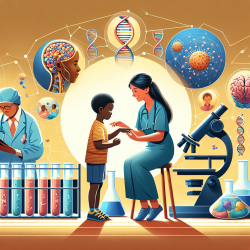Understanding NANS-CDG: A Pathway to Enhanced Pediatric Care
In the realm of pediatric neurology, congenital disorders of glycosylation (CDGs) present a complex challenge. Among these, NANS-CDG, a disorder linked to genetic variants affecting sialic acid synthesis, has been the focus of recent research. This blog delves into the findings of a pivotal study titled NANS-CDG: Delineation of the Genetic, Biochemical, and Clinical Spectrum, exploring how its insights can enhance clinical practice and patient outcomes.
Key Findings from the Study
The study, conducted across multiple countries, involved nine patients diagnosed with NANS-CDG. It highlighted several hallmark features of the disorder, including intellectual developmental disorder (IDD), facial dysmorphisms, neurologic impairment, short stature, and skeletal dysplasia. Notably, the research identified elevated urinary excretion of N-acetylmannosamine (ManNAc) as a biochemical marker correlating with clinical severity.
Moreover, the study uncovered novel features such as ophthalmological abnormalities, gastrointestinal dysfunction, and thrombocytopenia. These findings underscore the importance of comprehensive phenotyping in diagnosing and managing NANS-CDG.
Implications for Practitioners
For practitioners, the study offers several actionable insights:
- Screening and Diagnosis: The identification of ManNAc as a diagnostic biomarker provides a valuable tool for early detection. Practitioners should consider ManNAc screening in patients presenting with IDD, short stature, and neurologic impairments.
- Personalized Management: The study emphasizes the need for tailored care plans addressing the unique needs of NANS-CDG patients. This includes genetic counseling, management of gastrointestinal symptoms, and rehabilitation services for cognitive and physical impairments.
- Experimental Treatments: Encouraging results from experimental prenatal and postnatal treatment with oral sialic acid suggest potential therapeutic avenues. Practitioners should stay informed about ongoing trials and emerging therapies.
Encouraging Further Research
The study's findings open new avenues for research. Further exploration of the genotype-phenotype correlation and the role of sialic acid in neurodevelopment could lead to breakthroughs in treatment strategies. Collaboration between researchers and clinicians will be crucial in advancing our understanding of NANS-CDG and improving patient care.
Conclusion
The research on NANS-CDG provides a foundation for enhancing clinical practice and patient outcomes. By integrating these insights into their practice, speech language pathologists and other practitioners can contribute to better health outcomes for children with this complex disorder. For those interested in delving deeper into the research, the original study offers a comprehensive exploration of NANS-CDG's genetic, biochemical, and clinical spectrum.
To read the original research paper, please follow this link: NANS-CDG: Delineation of the Genetic, Biochemical, and Clinical Spectrum.










